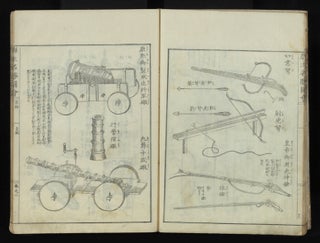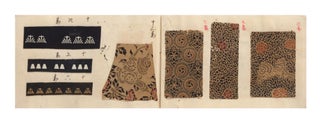“Initiated the Scientific Studies of Phonology in the
Ming & Qing Dynasties”
Maoshi guyin kao 毛詩古音考 [An Examination of the Ancient Sounds in the Mao Tradition of the Poetry Classic].
101.5; 81 folding leaves. Four juan in two vols. 8vo, orig. wrappers, stitched as issued. Chengdu, Sichuan: Fuwen Ge huichao edition, published by Long Wanyu, 1825.
First published in 1606; our edition is rare, with no copy found in WorldCat. Although Chen Di (1541-1617) spent his early working life as a successful military officer, he is best known as a scholar. Active in several fields, he is considered a key figure in historical Chinese phonology. His magnum opus, Maoshi guyin kao, represents a methodological innovation in the study of the sounds of the Poetry Classic, which dates from the first millennium BCE. This text occupied an important position within the Confucian tradition. It was written in verse over the centuries, and as the spoken language changed, the words of the poems no longer rhymed. To achieve a rhymed text, scholars altered the pronunciation of certain characters when reciting. Chen, by contrast, believed that the sounds of the Poetry Classic should be studied systematically and not be subjected to ad hoc alterations of individual pronunciations. Through systematic arrangement, Chen “determined with a fair degree of accuracy the ancient pronunciation for several hundred rhyming words” (Elman, From Philosophy to Philology, 215), using both evidence internal to the Poetry Classic and corroborating evidence from near-contemporaneous sources. This methodology has been seen as a forerunner of the phonological research of the Qing period. Moreover, it has been proposed that Chen’s approach was inspired by an encounter with European writing, since Chen’s friend and patron Jiao Hong (1540-1620) knew the Jesuit missionary Matteo Ricci (1552-1610), who is known to have discussed alphabetic writing with Chinese scholars and later published on the topic (Fang, “Ch’en Ti,” 183).
Maoshi guyin kao was begun in 1601 and completed during discussions with Jiao Hong in Nanjing, the Ming dynasty’s secondary capital, beginning in 1604. Chen then travelled to Dexing, Jiangxi to have the manuscript proofread by his older brother. Printing subsequently took place in Nanjing in 1606.
Chen’s work on phonology was recognized after his death, including in The Complete Writings of the Four Repositories, the late 18th-century catalogue of the Qianlong emperor’s manuscript library. Our edition was published in 1825 in Chengdu by Long Wanyu (1763-d. after 1833), a former official turned editor and publisher. Long published it as part of a series of works divided into sections on classics, history, and thought.
Fine set, preserved in a hantao.
References
Elman, Benjamin A. From Philosophy to Philology: Intellectual and Social Aspects of Change in Late Imperial China. Cambridge, MA: Council on East Asian Studies, Harvard University, 1984.
Fang Chaoying. “Ch’en Ti.” In Dictionary of Ming Biography 1368-1644. Edited by Goodrich, L. Carrington & Fang Chaoying. Vol. 1. New York: Columbia University Press, 1976.
Yan Shiming 顔世明 & Gao Jian 高健, “Qingdai keshu jia Long Wanyu shengping kaoshu” 清代刻书家龙万育生平考述 [“A Critical Account of the Life of the Qing period Publisher Long Wanyu”] in Wenshi tiandi 文史天地, No. 11 (2014), p. 75.
Yang Jianqiao 杨剑桥. “Maoshi guyin kao” 毛诗古音考 [An examination of the ancient sounds in the Mao tradition of the Poetry Classic]. In Zhongguo xueshu mingzhu tiyao (heding ben) 中国学术名著提要(合订本). Vol. 4. Shanghai: Fudan daxue chubanshe, 2019.
Price: $3,750.00
Item ID: 8682

![Item ID: 8682 Maoshi guyin kao 毛詩古音考 [An Examination of the Ancient Sounds in the Mao Tradition of the Poetry Classic]. Di 陳第 CHEN.](https://jonathanahill.cdn.bibliopolis.com/pictures/8682.jpg?width=768&height=1000&fit=bounds&auto=webp&v=1678892196)
![Maoshi guyin kao 毛詩古音考 [An Examination of the Ancient Sounds in the Mao Tradition of the Poetry Classic].](https://jonathanahill.cdn.bibliopolis.com/pictures/8682_2.jpg?width=320&height=427&fit=bounds&auto=webp&v=1678892196)



